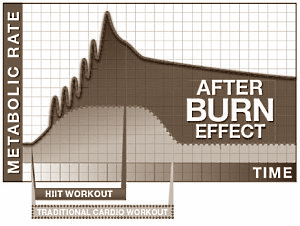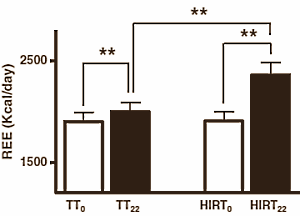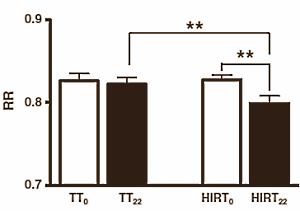|
Definition: "An ergogenic aid is any substance or phenomenon that enhances performance "
|
|
||||||||
25.02.2014 |
|
|
High-intensity interval resistance training boosts EPOC
EPOC is short for excess post-exercise oxygen consumption. In the 20th century physiologists discovered that after a high-intensity cardio training session or a strength-training workout the level of oxygen burned by the body remains elevated, and that the body is thus burning extra calories. After intensive exertion the body needs to repair all sorts of things and recover, both of which cost extra energy.
The EPOC effect is also referred to as the after-burn effect.
Brandt got 16 untrained women to do abductions on a machine [below left] and with an elastic band [below right]. The women used TheraBand exercise bands. Brandt placed electrodes on the women's legs, glutes and core muscles so he could measure the electrical activity in their muscles, which gave an indication of how intensively the women were using their muscles.

Interval training raises EPOC, as does strength training, so the researchers surmised that a combination of these two types of training might result in an extra strong EPOC effect. They published a study in the Journal of Translational Medicine in 2012 in which they described how they had tested this theory in an experiment involving 17 well-trained male strength athletes.
The researchers got their subjects to do strength training on two occasions, and measured how many calories the men burned in the first 22 hours after each session.
On one occasion the men trained in a traditional manner: they performed eight exercises, covering the largest muscle groups. They did 4 sets of each exercise using a weight with which they could manage a maximum of 12 reps. Between sets they rested for 1-2 minutes.
On the other occasion the men did high-intensity interval resistance training: they trained using weights with which they could just manage 6 reps. First they performed 1 set to failure, rested 20 seconds and then performed another set to failure. Most only managed 2 reps in the second set. The subjects then rested for another 20 seconds and then performed another set to failure.
For each of the upper-body exercises the men did two of these series. For the leg-muscle exercises they did three.
The men did just 3 exercises: the leg-press, chest-press and lat-row.
The figure below shows that the traditional form of strength training raised the men's calorie burning by 98 calories in the 22 hours after the workout. The high-intensity interval resistance training boosted the menís calorie burning by a whopping 452 calories.


The men's respiratory ratio [RR] was reduced after the high-intensity interval training, which would indicate that their fat burning increased.
Including the warming up the high-intensity interval training lasted 32 minutes. The Italians conclude that the short time required and the strong effect on fat burning opens up interesting perspectives.
"Our results suggest that high-intensity interval resistance training increases excess post exercise energy consumption to a significantly greater extent than traditional resistance training", the researchers write. "This exercise methodology allows subjects to improve metabolism and, at the same time, muscle mass and strength all of which are promoted as beneficial by many guidelines. In Western society leisure time is lacking and motivation to perform daily exercise is uncommon resulting in low overall levels of daily lifestyle related physical activity."
Source:
More: |
|

